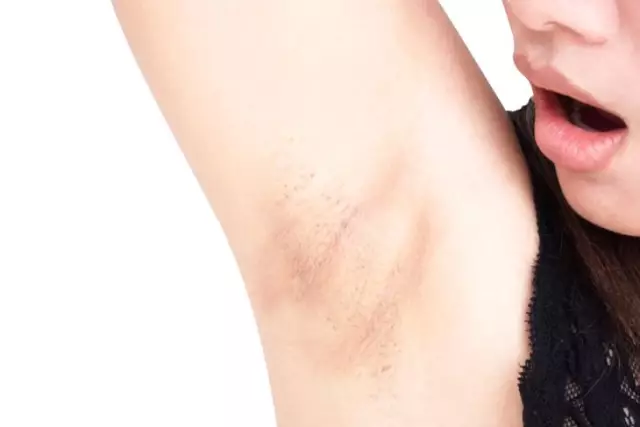- Author Curtis Blomfield [email protected].
- Public 2023-12-16 20:44.
- Last modified 2025-01-23 17:01.
Sweat glands in the human body play an important role. They perform a protective and excretory function, participate in the thermoregulation of the body. But there are situations in which uncontrolled sweating occurs. This significantly impairs the quality of human life. At the moment, there are several ways to treat this problem, one of which is endoscopic sympathectomy. What is this procedure and how it is carried out, we will consider in the article.
Definition of hyperhidrosis

Hyperhidrosis is a pathological condition characterized by excessive sweating. It can be general (when intense sweating is observed throughout the body) and local (in this case, the pathology affects certain parts of the body - palms, armpits, feet).
Hyperhidrosis can be congenital or acquired. The reasons that can cause the development of a pathological condition are the following factors:
- Stress.
- Pregnancy.
- Endocrine diseases.
- Infectious diseases.
- Rheumatism.
- Chronic intoxication.
Treatments
Currently, there are several ways to treat hyperhidrosis. Consider the most common of them:
Non-surgical. This method involves the use of antiperspirants and physiotherapy (for example, iontophoresis)

- Minimally invasive. Includes botulinum toxin injections.
- Invasive - curettage, laser and sympathectomy, which we will talk about in more detail.
Sympathectomy and its varieties
Sympathectomy is a type of surgical intervention in which some parts of the sympathetic system are blocked. As a result of the operation, impulses from a certain part of the nervous system cease to flow to the sweat glands.
Currently, sympathectomy has several varieties depending on the method of surgical intervention:
- Traditional. It is carried out in an open way. On the patient's body, the doctor makes large incisions to get the fibers of the nerve trunk. It is considered the most traumatic method, since the risk of complications is high. The recovery period is quite long. The operation leaves scars.
- Thoracoscopic. Used to treat hand hyperhidrosis.
- Lumbar. Allows you to get rid of hyperhidrosis of the feet and legs. It is quite traumatic.
- Endoscopic sympathectomy. OThis method will be described in more detail.
Definition

Endoscopic sympathectomy for hyperhidrosis is the most common treatment for this condition. It is performed under anesthesia and has minimal postoperative complications. This type of sympathectomy is used to treat excessive sweating of the upper body of a person. For the procedure, a special device is used - an endoscope.
The advantages of endoscopic sympathectomy are:
- For most patients, the duration of the rehabilitation period does not exceed one week.
- Subtle scarring from small incisions.
- The overwhelming majority of patients were helped by this treatment method.
When performing endoscopic sympathectomy, the feedback from patients and doctors in most cases is positive.
The main indication for surgery is hyperhidrosis, which could not be cured by traditional methods. Also, the indications include the following diseases:
- Raynaud's disease.
- Zudeck disease.
- Face redness.
Contraindications for endoscopic sympathectomy include:
- Tuberculosis.
- Operations on the abdominal organs.
- Secondary rehidrosis.
- Acute heart failure.
- Acute pulmonary failure.
Preparatory actions

Before surgerythe patient needs to undergo a series of laboratory and instrumental examinations to exclude pathological conditions in the body that may affect the course of surgery. Preparations include the following procedures:
- Clinical analysis of urine and blood.
- Biochemical blood test.
- ECG.
- Fluorography.
- Sometimes an ultrasound of the peritoneum is ordered.
Progress of operation

Endoscopic sympathectomy is currently performed in several ways. Let's take a closer look at them.
- Excision of the sympathetic trunk. This method allows you to quickly get rid of the symptoms of the disease, but also has a serious drawback - this type of surgical intervention is irreversible. If side effects occur, it is not possible to correct the situation.
- Without destruction of the sympathetic trunk (clipping). In this case, the nerve fibers are clamped with special staples, which, if desired, can be removed to restore nerve conduction. In endoscopic sympathectomy, clipping of the sympathetic trunks, according to patients, is the most advantageous treatment for hyperhidrosis.
The operation is carried out as follows:
- After the introduction of anesthesia, the surgeon uses a special device to make punctures in the sternum or armpits.
- After that, an endoscope equipped with a video camera and a light source is inserted into the resulting cavity. Imagewill be fed to a nearby screen, which allows the doctor to see the whole situation in full, which greatly reduces the risk of errors during the operation.
- Further, with the help of the introduced instruments, the sympathetic trunk is excised or a special titanium clip is applied to it. It depends on the choice of treatment method.
- Introduced instruments are removed, stitches are applied to the puncture sites.
With endoscopic sympathectomy, reviews after the operation confirm its effectiveness. Currently, hospitals have high-quality equipment for such operations.
Rehab
Recommendations to follow after surgery for 7-10 days are quite simple:
- Don't neglect your doctor's orders.
- Do not drink alcohol or smoke.
- Stop going to the beach or tanning beds.
- Do not take a bath, do not visit baths and saunas.
- See the doctor on time.
Complications

Despite the fact that, judging by the reviews, endoscopic sympathectomy is not a very difficult operation, the patient may experience some complications. These include:
- bruising;
- compensatory hyperhidrosis (this is the most common complication);
- pneumothorax;
- infection;
- hemothorax.
But such complications are quite rare and directly depend on the qualifications of the surgeon.
Conclusion
Hyperhidrosis is a rather unpleasant disease. In this regard, to improve the quality of life, it is recommended to consult a doctor for advice. Endoscopic sympathectomy, according to experts, is the most gentle method of treating this disease with a short rehabilitation period. Before the operation, it is necessary to consult a doctor regarding the choice of the method of its implementation.






